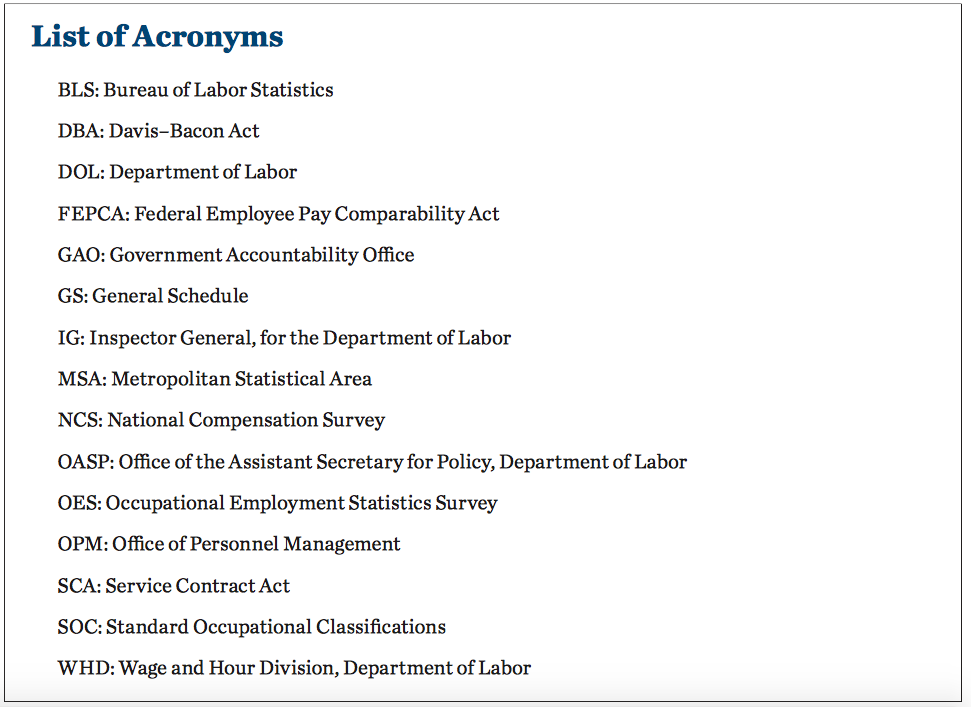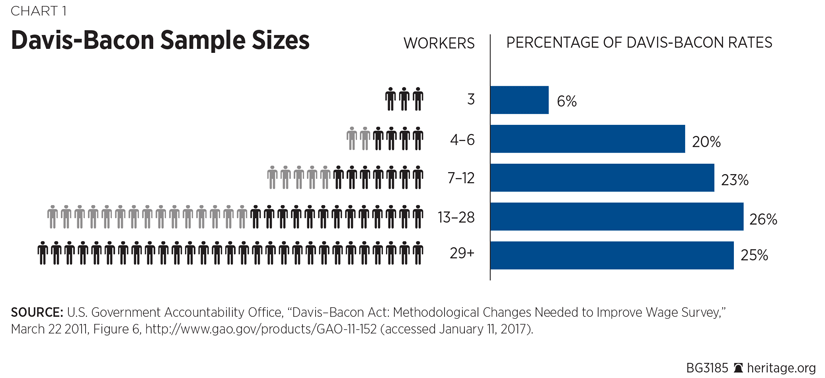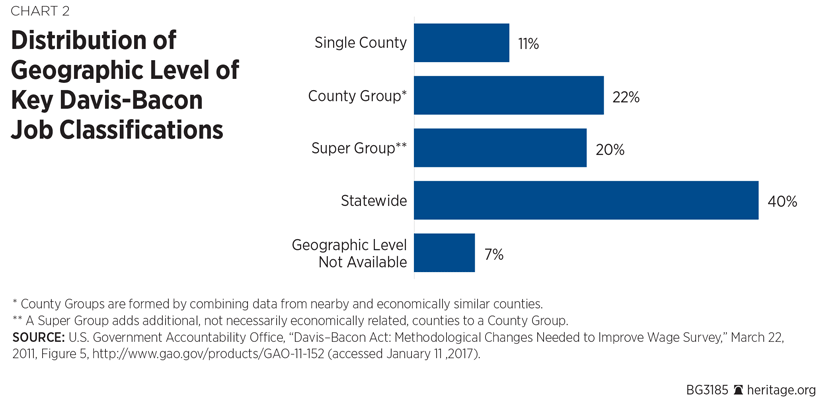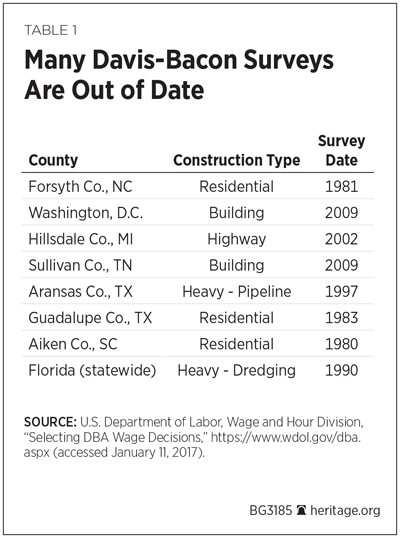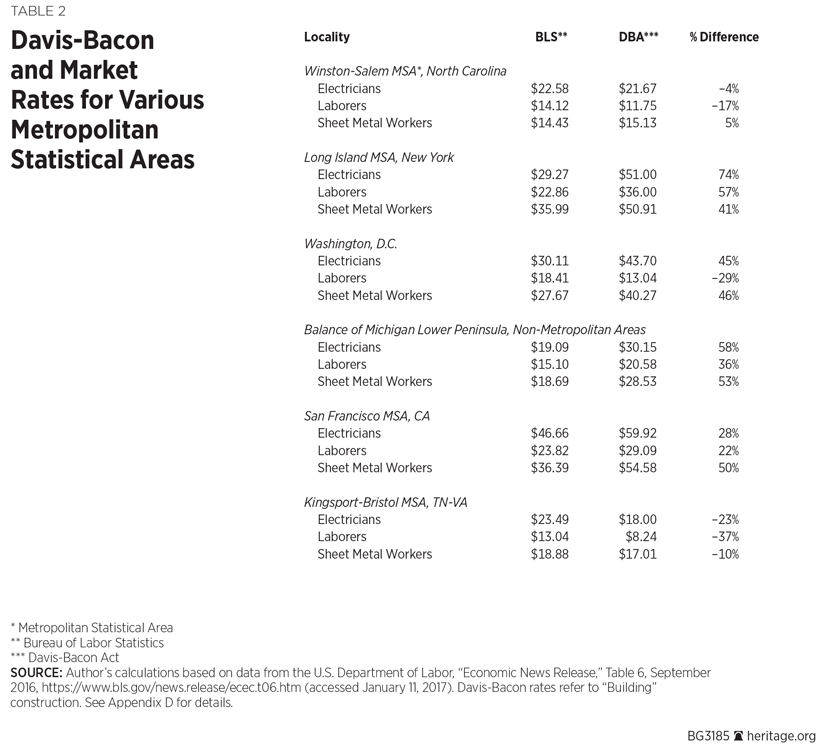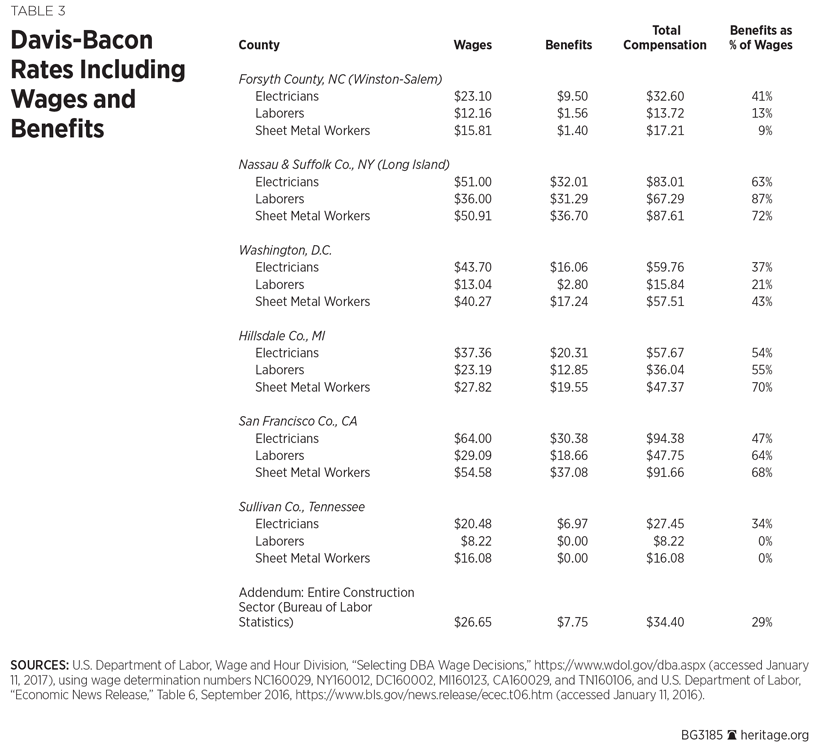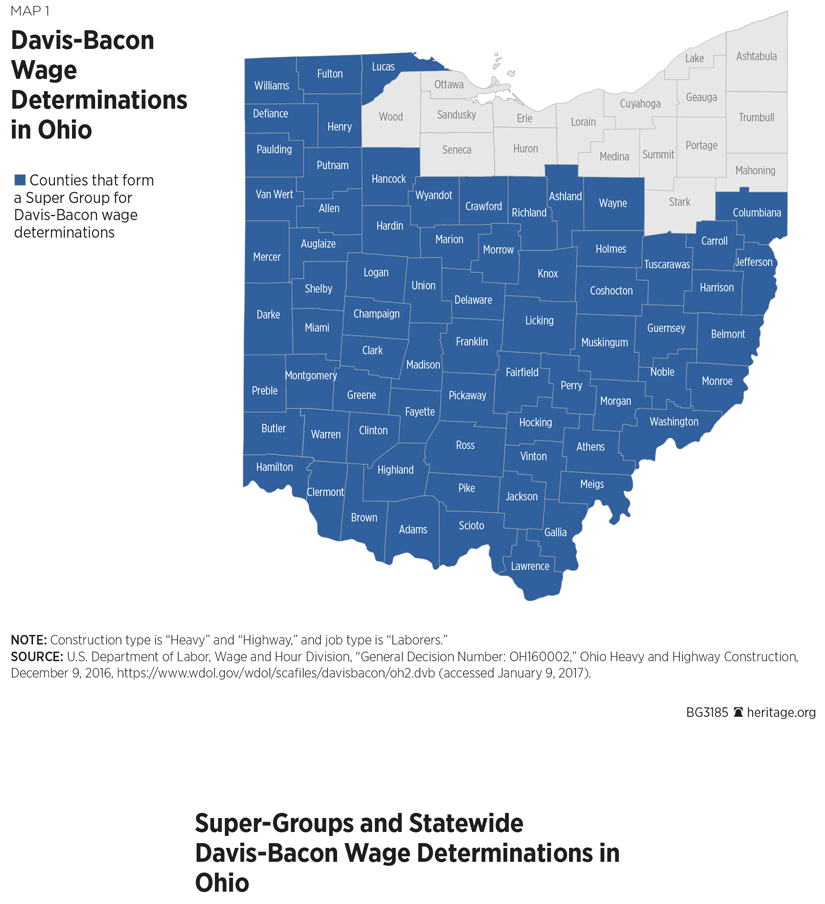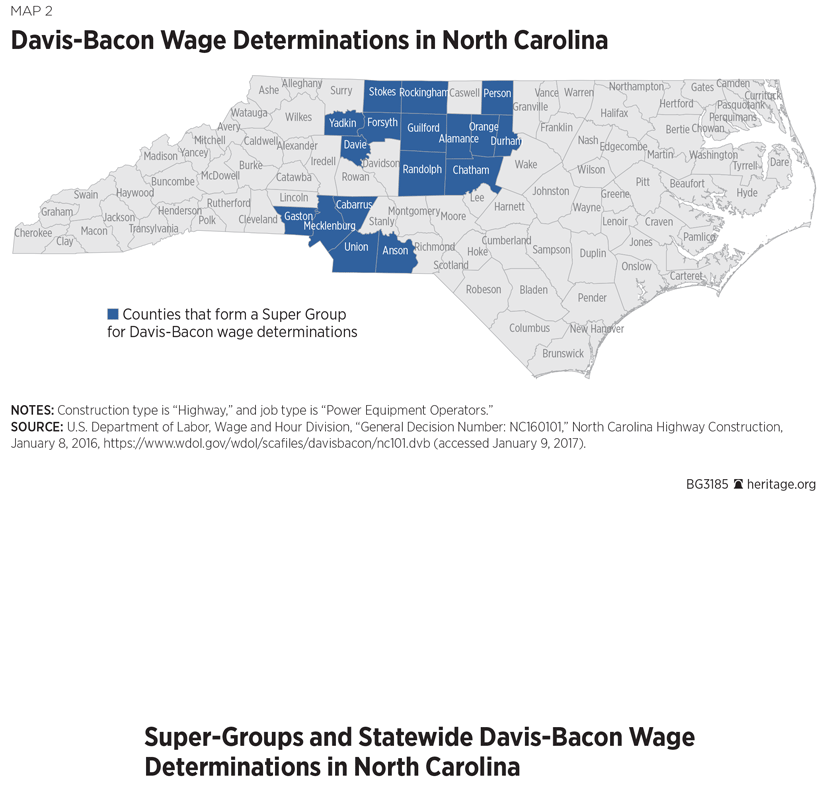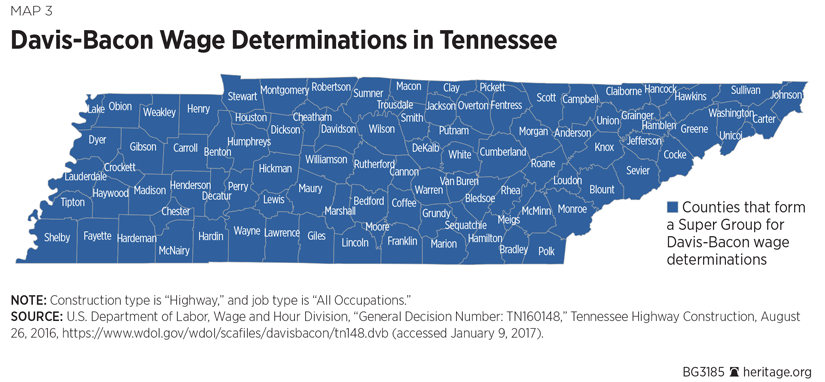The Davis–Bacon Act (DBA) requires federal construction contractors to pay “prevailing” wages. However, the Department of Labor (DOL) estimates these prevailing rates unscientifically. DBA surveys use tiny, statistically unrepresentative samples of the construction workforce. As a result, DBA rates differ markedly from true market wages.
Calculating DBA rates with Bureau of Labor Statistics (BLS) data would solve these problems. Two BLS surveys currently provide the information necessary to calculate Davis–Bacon rates:
- The Occupational Employment Statistics survey and
- The National Compensation Survey.
The government already uses these surveys to calculate prevailing wages for the Service Contract Act (SCA) and locality pay adjustments for federal employees.
More accurate data would reduce federal construction costs by approximately 10 percent. This would stretch construction appropriations over more projects, creating at least 30,000 new jobs on federal construction projects. The DOL can and should use BLS data for Davis–Bacon calculations.
The Davis–Bacon Act
The Davis–Bacon Act requires contractors on federally funded construction projects to pay at least as much as other construction workers in the area earn—the “prevailing wage.” This prevents contractors from winning contracts by hiring non-local workers at lower wages.
Congress originally passed the Davis–Bacon Act in 1931 as a Jim Crow policy. During the Great Depression, many African Americans moved to the North to find work. Some African Americans did land jobs on federal construction projects, but Congress wanted these jobs to instead go to white workers.[REF] Congress passed the Davis–Bacon Act to prevent minority workers from undercutting white workers on federal construction jobs.[REF] The Davis–Bacon Act remains on the books despite its racist origin. The Wage and Hour Division (WHD) of the Department of Labor (DOL) currently estimates the DBA prevailing rates contractors must pay.
The WHD is an enforcement agency. It investigates violations of federal labor requirements like the minimum wage and overtime pay. The WHD has no expertise in accurately surveying local wages. The Government Accountability Office (GAO) and DOL Inspector General (IG) have criticized the WHD for decades for using an unscientific method to estimate Davis–Bacon rates.[REF] The GAO and IG have identified four principal flaws in DBA wage surveys:
- They use unrepresentative, self-selected samples;
- They have unreliably small sample sizes;
- They combine data from economically unrelated counties; and
- They are typically out of date.
The WHD Uses Unrepresentative Samples
The first and largest problem is the WHD’s use of statistically unrepresentative surveys. Professional statistical agencies estimate wages by using representative samples achieved through random sampling. They then statistically extrapolate from these representative samples to the overall economy.
Absent a representative sample a survey indicates nothing about the economy. As Nobel Prize–winning economist James Heckman has noted, “Wage or earnings functions estimated on selected samples do not, in general, estimate population wage functions.”[REF] Any introductory statistics text will make the same point.[REF]
Non-representative samples are not scientifically valid. They only provide information about those who respond to the survey—not the overall economy.
Davis–Bacon Survey Is Self-Selected
A representative sample is unnecessary if the government knows the wages of every worker. Then the government could calculate average wages directly without generalizing from a sample. The WHD purports to have this information for construction workers. The WHD sends surveys to every construction firm in a given region,[REF] and then bases Davis–Bacon wages on the responses to this “census.” This method will provide accurate wage figures but only if every business responds.
However, most construction firms do not return Davis–Bacon surveys. The surveys require considerable time and effort to complete.[REF] The surveys also ask for information in a form that many construction companies do not track.[REF] If a company does not respond to the survey, the WHD sends a follow-up letter.[REF] If that letter goes unanswered, the WHD ignores that company.
This methodology leads to such low response rates[REF] that the WHD reduced its minimum data standards to wages for three workers from two companies. Too few employers responded to meet the old standard of data on six workers from at least three employers.[REF]Those employers who do respond tend to be those with large staffs. Unions also devote considerable effort to facilitate unionized employers completing and returning the surveys.[REF]
Consequently, Davis–Bacon rates are based on neither a representative sample nor a universal census of construction workers. Instead, the WHD bases its estimates on a self-selected sample of large, unionized businesses. Only 14 percent of construction workers are covered by union contracts.[REF] Nonetheless, the GAO reports that 63 percent of Davis–Bacon rates are union rates.[REF]
The Davis–Bacon survey is highly unrepresentative and, as a result, scientifically meaningless. Accurate prevailing-wage estimates cannot be made from non-representative samples. Davis–Bacon rates approximate actual prevailing wages only by chance.
Unscientifically Small Samples
The low response rates that make DBA surveys unrepresentative create a second problem. Even with a proper representative sample, WHD surveys too few workers to make statistically reliable estimates.
In general, averages in representative samples do not exactly match economy-wide averages. The power of statistical inference is that it allows researchers to estimate their margin of error. The sample may not exactly match the overall population, but researchers can determine how far off they are likely to be.
As sample size decreases, surveys become less accurate, and their margin of error increases. For example, a poll using a representative sample of 1,000 Americans has an error margin of ± 3.1 percent. A poll of 100 Americans has an error margin of ± 10.0 percent.[REF]
If sample sizes become too small, however, statisticians cannot even estimate the error margin. Statistical inference is based on the central limit theorem.[REF] The central limit theorem generally only applies to samples with at least 30 observations.[REF] Researchers cannot estimate how inaccurate smaller samples are.
The WHD primarily uses samples of fewer than 30 workers. The GAO reports that the WHD estimates only a quarter of Davis–Bacon rates on data from 29 or more workers. The WHD bases a greater proportion of rates (26 percent) on data from six or fewer workers.[REF]
Even a properly randomized representative sample of six workers would be too small to make statistical inferences from. No professional pollster would conduct a survey of six voters.
The WHD minimum data standards are observations on three workers from two employers. That minimum standard should be at least 30 randomly selected workers. The WHD’s existing methodology lacks statistical validity.
Agglomerating Unrelated Counties
The WHD’s low response rates also drive the third problem with Davis–Bacon wage determinations: They typically combine data from economically unrelated counties.
If the WHD gets enough survey responses from a single county to meet its minimum data standards, it will issue a county-level wage determination (for that occupation and work type).[REF] However, the WHD’s low response rates mean this happens infrequently. Consequently, the WHD frequently combines surveys from multiple counties.
In principle, this makes sense. Supply and demand conditions in local labor markets determine wages; workers in similar jobs in the same labor market typically have similar pay. The Bureau of Labor Statistics estimates wages at the Metropolitan Statistical Area (MSA) level—groupings of counties that commuting patterns show share the same labor market.
The WHD initially follows similar procedures. If it does not have enough data from one county, then it tries to assemble sufficient data from a “group” of similar nearby counties.[REF] These procedures are reasonable. However, combining surveys from economically similar counties usually does not provide enough data. The GAO reports that only a third of Davis–Bacon determinations occur at the county or group levels.[REF]
The WHD consequently calculates most Davis–Bacon rates by agglomerating data from counties in different labor markets. The GAO reports that 20 percent of key DBA rates occur at the “super-group” level.[REF] But frequently even super-groups do provide sufficient data. Fully 40 percent of Davis–Bacon rates are based on statewide data.[REF]
Super-group and statewide determinations combine data from economically unrelated counties. There is no reason to expect workers in Miami-Dade County to make the same as workers in the Florida panhandle. Nor do workers in rural and urban Ohio typically make the same amount. The WHD frequently assumes that they do.
Even if the WHD used statistically representative surveys with reasonable sample sizes it could not estimate local wages from statewide data. The WHD’s current methodology is incapable of estimating locally prevailing wages.
Outdated Estimates
DBA surveys suffer from a fourth problem: many of them are out of date. The WHD reports their average DBA rate is approximately four years old.[REF] However, the GAO has shown this headline figure is overly optimistic.
The WHD only intermittently conducts its prevailing-wage surveys. If 50 percent or more of an occupation’s survey respondents are unionized, the WHD uses their union rate. Going forward, the WHD updates that rate—without conducting a new survey—when the union renegotiates its collective bargaining agreement. Consequently, DBA union rates are updated fairly frequently.[REF]
However, the remaining rates are not updated until the WHD conducts a new survey, for which the wait time can be significant. The GAO reports that about half of survey wage rates are 10 years old or older.[REF] Table 1 shows the age of some of these DBA surveys.
- The Washington, DC, building construction survey is eight years old.
- The WHD has not surveyed residential construction wages in Forsyth County, North Carolina, since 1981.
- The WHD has not updated its highway construction survey covering Hillsdale, Michigan, since 2002.
- The last survey of heavy dredging workers in Florida occurred in 1990, which has put the WHD’s dredging rates below Florida’s minimum wage.[REF]
Even if the WHD used a scientific survey methodology, decade-old wage estimates would not reflect prevailing wages.
Inaccurate Wage Estimates
The WHD’s unscientific methodology causes DBA wages to frequently bear little relation to actual market wages. Table 2 shows how Davis–Bacon rates differ from market wages (as estimated by the Bureau of Labor Statistics) in several metropolitan areas. Appendix D explains the methodology underlying these comparisons in detail.
Most DBA rates stand well above market pay. Consider the following examples:
- DBA rates for sheet metal workers in the San Francisco MSA are $54.58 an hour—50 percent higher than median market wages of $36.49 an hour.
- DBA rates for electricians on Long Island, New York, are $51.00 an hour—74 percent higher than the market rate of $29.27 an hour.
- DBA rates for laborers in the non-metropolitan areas of Michigan’s Lower Peninsula are $20.58 an hour—36 percent higher than their actual market wages of $15.10 an hour.
However, DBA rates in some areas fall below market pay. This occurs especially frequently in non-urban areas with low union density.
- The BLS estimates that electricians in the Kingsport-Bristol MSA (including parts of both Tennessee and Virginia) make $23.49 an hour, but their DBA rates are $18.00 an hour—23 percent lower.
- The BLS estimates that construction laborers in the Winston-Salem MSA make $14.12 an hour, while the WHD estimates they make only $11.75 an hour—approximately 17 percent lower.
Economists with the Beacon Hill Institute at Suffolk University conducted a detailed comparison of Davis–Bacon and market wages across the entire U.S. They found that DBA wage rates stand on average 22 percent above market wages.[REF]
The existing WHD methodology results in immensely inaccurate wage calculations.
Inaccurate Benefits
The WHD’s methodological flaws also affect DBA benefit estimates. The DBA requires paying both minimum wages and minimum benefits. In many localities the DBA benefit rates are implausibly large or small, substantially affecting total compensation.
The BLS estimates that benefits are worth an average of 29 percent of wages in the construction sector.[REF] In many cities DBA benefit rates are nowhere close to this amount. Table 3 shows DBA wage and benefit rates for selected counties within the MSAs highlighted in Table 2. (Exact comparisons with market rates are not possible because the BLS does not estimate employee benefits at the local level.)[REF]
In populous urban areas, DBA benefits stand well above the BLS baseline.
- On Long Island, New York, the DBA benefit rate for electricians is $32 an hour. That represents 63 percent of the DBA wage rate of $51 an hour and total compensation of $83 an hour.
- In San Francisco, California, the DBA rate for sheet metal workers is $37.08. That represents 68 percent of their $54.58 base hourly wages. Sheet metal workers on federal projects in San Francisco make $91.66 an hour in total compensation.
These benefit figures are implausibly large.
In non-urban jurisdictions some DBA rates understate benefit costs.
- The DBA surveys for Sullivan County, Tennessee, report that construction laborers and sheet metal workers are not paid any benefits at all.
- In Forsyth County, North Carolina, sheet metal workers supposedly make only $1.40 an hour in benefits.
These figures are implausibly small.
The WHD Davis–Bacon surveys fail to accurately estimate both wages and benefits.
The WHD’s Methodology Violates the Law
The WHD surveys are arguably so flawed that the Labor Department could be violating the law. The Davis–Bacon Act requires that
every contract in excess of $2,000, to which the Federal Government or the District of Columbia is a party, for construction…shall contain a provision stating the minimum wages to be paid various classes of laborers and mechanics.
The minimum wages shall be based on the wages the Secretary of Labor determines to be prevailing for the corresponding classes of laborers and mechanics employed on projects of a character similar to the contract work in the civil subdivision of the State in which the work is to be performed, or in the District of Columbia if the work is to be performed there.[REF]
The flawed WHD methodology produces DBA rates bearing little relation to prevailing construction wages. Employers paying DBA rates overpay some workers and underpay others—often by considerable amounts.
Moreover, the WHD bases most DBA rates on surveys of workers in counties far removed from the work site. In many cases, these counties have little economic connection to the county where the work is performed.[REF]
Maps 1, 2, and 3 visually display the extent to which the WHD agglomerates unrelated counties. The maps show the geographic levels at which selected Davis–Bacon wage determinations occur in Ohio, North Carolina, and Tennessee.
The WHD calculates highway power equipment operators’ wages in Forsyth County, North Carolina (i.e., Winston-Salem), from a super-group of 17 counties.[REF] This super-group is much larger than the Winston-Salem MSA.[REF] It is not even contiguous. Highway laborers across most of Ohio are part of an even larger super-group of 72 counties.[REF] Every Ohio county outside northeast Ohio belongs to the same super-group. In Tennessee, all highway construction rates are estimated using statewide data.[REF]
The DOL does not meaningfully estimate local prevailing wage rates as the Davis–Bacon Act requires.
30,000 Fewer Construction Jobs
Inaccurate DBA rates hurt both taxpayers and construction workers. In some cities, artificially low rates encourage contractors to pay lower wages and benefits.[REF] In most cities, Davis–Bacon rates unnecessarily raise construction costs. In essence, the government hires four construction workers for the price of five. Construction workers fortunate enough to work on a federal project undoubtedly appreciate this premium. However, the Beacon Hill Institute estimates these inaccuracies inflate federally funded construction projects’ costs approximately 10 percent.[REF]
Congress could build more infrastructure projects at no extra cost if the DOL used accurate wage determinations. This would enable the government to provide more public services and create an additional 30,000 jobs on federal construction projects.[REF] In addition, more jobs would be created on joint state-federal construction projects.[REF]
The DOL has an obligation to estimate prevailing wages accurately. Overpaying some workers and underpaying others hurts both workers and taxpayers.
The BLS Has Statistical Expertise WHD Lacks
The WHD estimates prevailing wages so poorly because it is an enforcement agency, not a professional statistical agency. It has no expertise in conducting scientific wage surveys, whereas the Labor Department contains another agency that has this expertise.
The Bureau of Labor Statistics exists to conduct scientific surveys of labor market conditions. Its methodology, accuracy, and data quality are internationally respected. The BLS already conducts two major surveys that estimate occupational wages and avoid the problems plaguing the WHD surveys:
- The National Compensation Survey (NCS), which estimates benefits at the national level; and
- The Occupational Employment Statistics (OES) survey, which estimates local occupational wages.
Both the OES and the NCS have large sample sizes, are conducted in a timely manner, and are updated annually.[REF] The OES also surveys wages at the metropolitan (and non-metropolitan) statistical area levels, which means its estimates use only data from economically interrelated counties. Most importantly, the BLS takes several steps that make these surveys statistically representative.
BLS Surveys Are Statistically Representative
First, the BLS strives to make its surveys as easy as possible to understand and complete. They test their surveys with employers before they put them in the field to ensure ease of use. The WHD does not do this.[REF]
Second, the BLS follows up with employers who do not initially respond. This includes telephone calls and, in some cases, on-site visits to collect the required information.[REF] As a result, BLS surveys have high response rates. For example, approximately 80 percent of construction firms respond to the Occupational Employment Statistics survey.[REF] These high responses help make BLS surveys representative of the overall population.
Third, the BLS does not ignore employers who do not respond. Instead, it makes two principal adjustments to correct for their absence: weighting and imputation.
- Weighting involves adjusting the importance given to the respondents of the survey based on how likely they are to respond. Those groups who were more likely to respond count for less and vice versa. Pollsters do this on a regular basis. For example, a pollster might survey a state and get a sample with 60 percent men and 40 percent women. In fact, that state has equal numbers of men and women (women simply responded in lower numbers). The pollster would adjust the weight given to men’s and women’s responses so that both groups contributed equally to the final results. The BLS weights responses by variables like firm size so it does not over-represent large businesses.[REF]
- Imputation involves substituting a missing response with a response from a similar respondent or respondents. For example, if a small construction firm does not return the OES survey, the BLS does not assume that it has no employees. Instead, the BLS would randomly select another nearby small construction firm that did respond and treat its response as the response of the missing firm.[REF] This introduces some error into the sample—but much less error than by completely ignoring non-responders.
The WHD does not weight Davis–Bacon survey responses or impute missing data, nor does it conduct any analysis of contractors who do not respond.[REF] The WHD does not take statistical measures to obtain a representative sample; the BLS does.
The DOL Can Use BLS Data for Davis–Bacon Enforcement
The DOL should calculate Davis–Bacon wages using BLS data. Unlike the WHD, the BLS uses a scientifically rigorous methodology. Furthermore, the WHD currently uses OES data to enforce two other prevailing-wage requirements: the Service Contract Act and the Foreign Labor Certification program.[REF] If the DOL wants accuracy, then the WHD should also use BLS data to calculate DBA rates.
One of the main objections to using BLS data is that no single BLS survey provides all the data required by the Act. Instead, two BLS surveys estimate these statistics separately. The OES estimates MSA-level occupational wages. The NCS estimates pay and benefits at the national level. If DOL wants to use BLS data, it must reliably combine these surveys.
Economists at the BLS have already developed a methodology doing this.[REF] The Federal Employee Pay Comparability Act (FEPCA) requires that the Office of Personnel Management (OPM) set federal pay using BLS data.[REF] As with the DBA, no single BLS survey provides the data needed to comply with the FEPCA’s mandates. The OES provides detailed data on local occupational wages. The NCS provides national data on how occupational pay varies according to “levels of work” that the OPM needs to calculate pay for different General Schedule (GS) grades.
BLS staff economists developed a regression model combining OES local wage data with NCS data on how pay varies according to work levels. Their validation analysis showed the model works well and produces reasonably reliable estimates. The federal government currently sets its own employees’ pay by combining OES and NCS data with this model.[REF]
The DOL could use a similar model to estimate DBA prevailing wages much more accurately. Appendix A provides technical details about how the DOL could adapt the OPM model to meet DBA statutory requirements. This would involve using OES data to estimate local occupational wages and NCS data to estimate the relationship between pay and benefits.
Steps Forward
The DOL can and should use BLS data for DBA determinations. Implementing this change will require going through the notice and comment process for new regulations. The Secretary of Labor has delegated authority for conducting DBA determinations to the WHD.[REF]
While the WHD could promulgate such regulations, the Office of the Secretary of Labor is better positioned to promulgate these regulations. Under the Trump Administration, the WHD will have a full agenda rolling back many of the Obama Administration’s initiatives. The WHD may not have the bandwidth, so to speak, to prioritize improving DBA determinations, nor does it have in-house economists who could work with the BLS to develop the model matching OES and NCS data.[REF]
The Office of the Secretary of Labor is better positioned to issue regulations switching DBA determinations to BLS data. Going through the Secretary’s Office would have several benefits, including:
- The Secretary’s Office can best coordinate political, legislative, and legal responses to opposition from unions that will strenuously oppose DBA reforms.
- The BLS reports directly to the Secretary of Labor, so the Secretary’s Office can direct the BLS to cooperate with these reforms. The BLS has historically resisted proposals to use its data for DBA determinations. The BLS has wanted to avoid union pressure to produce inaccurate figures. The Secretary’s Office has more institutional ability than the WHD to both assuage these concerns and overcome this resistance.
- Unlike the WHD, the Office of the Assistant Secretary for Policy (OASP) employs many highly trained economists and statisticians. The Secretary’s Office can direct the OASP to work with the BLS to model the best way to use OES and NCS data. This task falls squarely within the OASP’s mission of providing regulatory support to the Secretary.[REF]
- The Secretary’s Office has greater capacity to issue regulations without undue delay, while not skimping on legal obligations under the Administrative Procedure Act’s notice and comment process.
- The Secretary’s Office can transfer survey funding from the WHD to the BLS.
The final point deserves more explanation. While the OES and the NCS provide enough data to estimate DBA rates, the OES has smaller sample sizes in non-urban MSAs. This makes these survey estimates less precise (just as a survey of 200 voters is less precise than a survey of 1,000 voters). The DOL can ameliorate this imprecision by transferring DBA survey funding from the WHD to the BLS.[REF]
The WHD is likely to resist losing funding. Nonetheless, the Secretary’s Office can transfer survey funding administratively.[REF] The Secretary can further direct the BLS to use those funds to expand the OES and NCS construction samples.[ ]Larger BLS sample sizes would produce better wage estimates. Eliminating the WHD’s survey office also would make it difficult for a future administration to resume using WHD’s flawed surveys.
Conclusion
The WHD’s calculations of Davis–Bacon Act prevailing wages are woefully inaccurate. The WHD uses small and statistically unrepresentative samples, calculates local wages using statewide data, and takes years to update its surveys. DBA rates bear little resemblance to actual construction compensation.
The DOL should set DBA wages using BLS data. Economists at the BLS have already developed methods for combining their wage and benefits survey. The federal government uses the BLS model to set its own employees’ pay. The DOL’s adaptation of that model for Davis–Bacon determinations would allow the federal government to build 10 percent more infrastructure projects for the same cost as current appropriations, generating at least 30,000 new construction jobs.
Appendix A: How the DOL Can Use BLS Data for DBA Determinations
Under the Clinton Administration, the DOL decided against using BLS data for DBA determinations. Two of the major reasons for this decision were:
- BLS wage determinations are not available for every occupation in every area of the country and
- The “BLS does not currently provide an effective, feasible method for collecting fringe benefit data for specific occupations and localities.”[REF]
These problems are similar to the challenges in using BLS data to calculate federal employees’ pay. The BLS and the OPM have overcome these challenges. The DOL can use a modified version of their approach. This Appendix provides a technical explanation of how the DOL can do so.
OES and NCS Surveys
Two BLS surveys are relevant for DBA determinations:
The OES survey has broad geographic coverage but does not survey benefits. The OES collects wage and industry data for roughly 800 occupations from a representative sample of 1.2 million employers. It provides this data at the metropolitan (or non-metropolitan) statistical area level.
The NCS covers wages, benefits, and work duties. Until 2011, the NCS had a larger sample size and provided local wage and benefit estimates in roughly 150 metropolitan areas. Budget prioritization caused the BLS to reduce the NCS sample size to roughly 7,000 private-sector businesses and 1,500 state and local government units. The NCS currently produces nationally representative wage and benefit estimates but no longer estimates local area figures.
The Davis–Bacon Act requires the DOL to estimate local construction wages and benefits by occupation and project type (e.g., non-residential buildings or highway construction). The OES and the NCS collect this information separately. To use BLS data, the DOL would have to develop a model combining data from these two surveys.
The OPM faced a similar challenge to this when the BLS reduced the NCS sample size. The FEPCA requires federal pay to vary according to local wage levels, as well as private-sector pay for similar occupations and job duties. The NCS collects wage data for detailed occupations and “levels of work” (comparable to General Schedule grades). Until 2011, the OPM set federal pay solely with NCS data, but this was no longer possible after the BLS eliminated the NCS locality samples.
The OPM worked with the BLS to develop a model combining OES information about local occupational pay rates with NCS data on how average pay varies according to job duties. Analysis from the BLS showed the combined approach estimated pay more precisely than the earlier model using only NCS data.[REF] The OPM currently uses this combined OES-NCS model to set the pay of approximately 2 million federal employees. The DOL can use a similar model to determine DBA rates.
Benefits Regression Model
The OPM uses a regression model that takes OES wages for a given occupation and industry as a baseline, then uses NCS data to estimate how individual pay varies from that baseline according to job characteristics and expected GS grade.[REF] The DOL can use a similar model that uses NCS data to estimate construction benefits, given information on OES wages, occupation, industry, and urban or rural status.
For example, define ln(Bi) as the natural log of the hourly benefits earned by the ithworker in a construction occupation in the NCS sample. Define ln as the log of the average wages paid to workers in occupation o in MSA a in the OES. The DOL could estimate the following regression equation:
Where Occupationo,i is a vector of indicator variables for whether the ith individual belongs to occupation o or not, Industryn,i is a vector of indicator variables for whether or not the ith individual belongs to industry group n (where the industry groups are defined similarly[REF] to current WHD practices), and Urbana,i is a vector of indicator variables for the urban characteristics of MSA a that the ith individual resides in, and εiis the regression residual.[REF]
This model treats the benefits the ith worker earns as a function of OES wages for workers in their occupation and area, their occupation, industry, and urban status. Both wages and the square of wages enter into the model to account for the fact the relationship between wages and benefits is unlikely to be strictly linear (i.e., a worker making $30 an hour will usually earn more benefits than one making $15 an hour, but he probably does not receive exactly twice the benefits). The DOL can then use the regression coefficients and local OES wage data to calculate the benefits earned for workers in each occupation and construction type.
Equation (1) is not meant to specify the exact regression equation the DOL should use. Economists at the DOL should experiment with various functional forms to see which model best fits the data. For example, it may be appropriate to include interaction terms. Equation (1) is meant to show the type of model the DOL could use to combine OES and NCS data to estimate both wage and benefit rates. The OPM has found this type of model effective in setting federal pay. The DOL can use a model like this for DBA determinations.
Combining two surveys with a statistical model will introduce some statistical error. Such a model would nonetheless be more accurate than the WHD’s current unscientific surveys and is also well within the DOL’s statutory discretion. The WHD sets one nationwide benefit rate for Service Contract Act workers (currently $4.27 an hour).[REF] The SCA has almost identical statutory requirements as the DBA. If the DOL can enforce those requirements using a single nationwide rate it can certainly calculate more precise local estimates combining OES and NCS data.
Modeling Missing Wage Data
The OPM has overcome another difficulty with using OES and NCS data: The BLS does not produce wage estimates for every occupation in every geographic area.
The BLS frequently samples too few workers in a MSA to reliably estimate wages for every occupation. In these cases—unlike the WHD—the BLS only publishes data on occupations with sufficiently large sample sizes. Consequently, in many MSAs, wage estimates do not exist for certain occupations. For example, the OES does not publish wages for roofers in the Lynchburg, Virginia, MSA. The Clinton Administration cited this as a reason for not using BLS data.[REF]
The OPM faced a similar challenge when setting federal locality pay. BLS estimates do not cover all the occupation-locality combinations on which the OPM needs data.[REF] As a result, the OPM uses a regression model to extrapolate wages for missing occupations. The DOL can take the same approach. A version of the OPM model applied to DBA determinations would look like this:
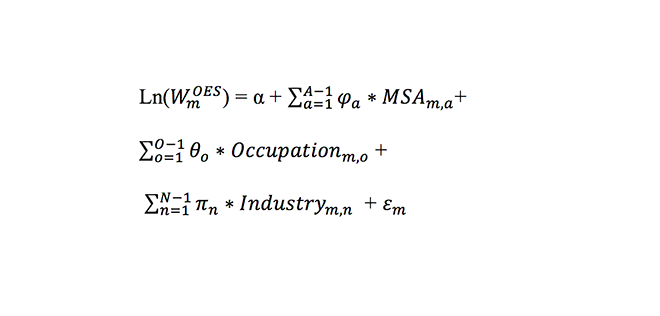
Where WmOES is the average wages in the OES for the mth construction job (occupation-MSA–industry sector combinations), and MSAm,a, Occupationm,o, and Industrym,n are vectors of variables indicating the MSA, the occupation, and industry sector that job m belongs to, with εm the regression residual. The model would be estimated with weighted least squares.[REF]
This model estimates how much average pay differs between locations, occupations, and industries. The DOL could use those estimates to extrapolate wages in missing occupation-industry combinations in the OES data. Continuing the example, this regression model could hypothetically predict that construction workers in Lynchburg, Virginia, earn 3 percent less than the national average; that roofing pays 2 percent more than the average construction occupation; and that workers on non-residential building projects earn 5 percent more than in the average industry. In which case the model would predict wages for the average Lynchburg roofer on a non-residential building project are approximately 4 percent (–3 + 2 + 5) higher than the average construction wage nationwide.
Again, DOL economists would have to experiment with various functional forms of this model to see which best fits the data.[REF] The BLS and the OPM found that a version of equation (2) had high explanatory power and performed as well as reasonable alternatives.[REF] Millions of federal employees’ pay have been set by modeled wage determinations. The DOL can similarly use modeled wages for DBA determinations. Such determinations would reflect local wages much more accurately than self-selected statewide surveys of a handful of workers.
Any survey has a margin of error causing it to change from period to period. The WHD has an internal rule that SCA wage determinations cannot change by more than 10 percent in consecutive years. If the WHD also uses BLS data for DBA purposes, it should adopt a similar rule.
Mean or Median Wages
The DOL should carefully determine whether to use mean or median pay and benefit rates. Equations (1) and (2) call for using average OES wages. Regression analysis typically examines how independent variables affect the average value of the dependent variable (e.g., wages). Averages have many desirable mathematical properties.[REF]
Nonetheless, medians are most appropriate when estimating prevailing wages. The median wage is that wage which is more than exactly 50 percent of workers make. This most closely matches the definition of “prevailing.”[REF] The WHD generally uses medians when enforcing the Service Contract Act. Median wages are also generally 5 percent to 15 percent lower than average wages in the construction sector, so using average wages could artificially inflate DBA rates.
The WHD could easily calculate median OES wages for jobs where the BLS publishes data. But for jobs with missing data, equation (2) will not in general accurately estimate median wages. The DOL would have to use quantile regression techniques to estimate conditional medians. This would require analyzing the unpublished OES micro-data.[REF]
Equation (1) could similarly be re-estimated using quantile regression techniques to estimate median benefits, conditional on wages, occupation, urban status, and industry. However, adding median wages and median benefits will not in general estimate median total compensation. One possible solution to this problem would involve re-estimating equation (1) using solely NCS wage data as:
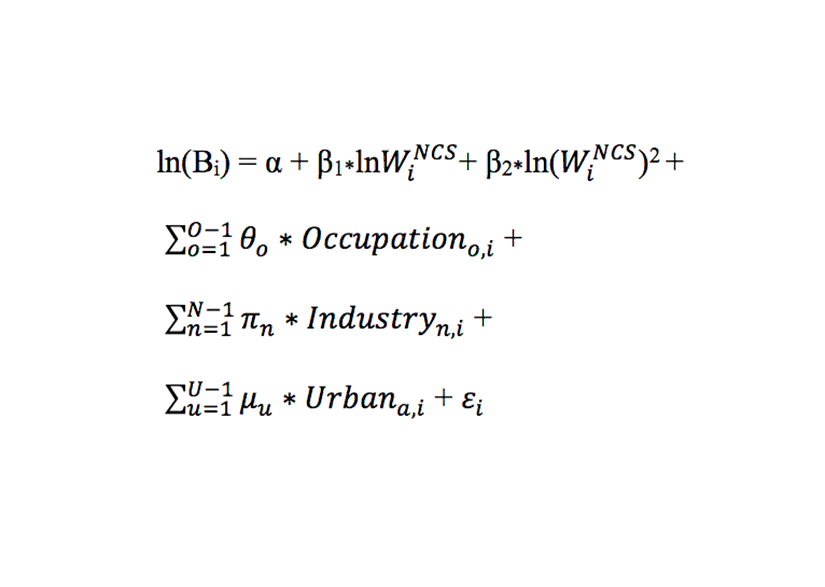
This would allow the DOL to estimate average benefits for a given level of wages (not just the OES average), depending on industry, occupation, and urban status. That relationship could be applied to OES data to model average benefits for workers at the median wage in each MSA-occupation-industry group. This would involve adding average benefits to median wages. Such an approach may be the only practical way to estimate median compensation by combining separate wage and benefit surveys.
Appendix B: Addressing Additional Concerns with Using BLS Data
Opponents of using BLS data for DBA determinations have raised several objections besides those discussed in Appendix A. This Appendix discusses those objections and shows that they can (or have already been) overcome.
The DBA Allows the WHD to Use MSA-Level Surveys
The Davis–Bacon Act requires prevailing-wage estimates for each “civil subdivision” (i.e., county). A 2004 Inspector General report claimed Congress would have to amend the DBA for the DOL to use BLS surveys that combine data from multiple counties.[REF]
This objection misinterprets the DBA. The statute only says the DOL must issue county-level determinations; it does not prevent the DOL from basing those determinations on multi-county surveys. The DC Circuit Court of Appeals has expressly upheld the DOL’s authority on this point. As the court held in a 1983 decision that remains good law:
[T]he legislative history of the statute suggests that Congress contemplated that the Secretary’s authority to determine prevailing wages extended to finding the best way to do so…. Clearly, if a prevailing wage could not be set in a given county by looking only to projects in that county, it was essential to the attainment of the general purpose of Congress—the predetermination of locally prevailing wages—that another mechanism be found.
In cases where there is insufficient data from a given civil subdivision to determine a prevailing wage, therefore, the Secretary is acting pursuant to the same kind of delegation of authority that we discussed above with regard to the formula for deriving a prevailing wage from the data collected.[REF]
The WHD responded to the IG by explaining that “the Davis–Bacon Act does not prohibit issuing wage determinations for broader geographic areas such as an MSA, and we routinely issue such wage determinations when sufficient data are not available on a county basis.”[REF] Only 11 percent of DBA determinations are based entirely on county-level data; 60 percent are based on super-groups or statewide surveys. Using MSA-level BLS data—instead of statewide or super-group determinations—is within the DOL’s legal authority. Doing so would make DBA rates more reflective of local pay.
The DOL Can Use National Occupational Definitions
Contractors on DBA projects must follow the DOL’s occupational definitions. They themselves may not define occupational responsibilities. This prevents contractors from classifying more highly paid workers (like electricians) as filling lower-paying occupations (like laborers) to reduce costs. As the DC Circuit Court of Appeals has noted: “[W]age rates and classifications are essentially two sides of the same coin—they must be fixed in tandem to ensure that a given wage will be paid for given work.”[REF]
The DOL currently requires using union job classifications on most DBA projects. These classifications vary according to local collective bargaining agreements and essentially incorporate union work rules. For example, union classifications may assign different responsibilities to workers called “electricians” in different cities. Similarly, they may require paying higher wages to electricians working on the second floor of a building than on the ground floor.
The DOL cannot readily combine BLS compensation data and union job classifications. The BLS collects compensation data using a nationwide occupational classification—the Standard Occupational Classification system (SOC). The DOL cannot reliably translate SOC occupations into entirely different union job classifications—especially if those classifications vary from city to city.
However, as the DC Circuit Court of Appeals has explained, “nothing in the statute requires the Secretary to implement ‘the union[s’] classification scheme.’”[REF] The DOL has simply decided to enforce the Act this way. The DOL enforces another prevailing-wage law with very similar statutory language quite differently. The Service Contract Act requires that:
Every contract (and any bid specification therefore) entered into by the United States or the District of Columbia in excess of $2,500…the principal purpose of which is to furnish services in the United States through the use of service employees, shall contain…
A provision specifying the minimum monetary wages to be paid the various classes of service employees in the performance of the contract or any subcontract thereunder, as determined by the Secretary, or his authorized representative, in accordance with prevailing rates for such employees in the locality.[REF]
The WHD enforces these requirements with national occupational definitions based on BLS occupational categories.[REF] The DOL has similar discretion to establish national occupational definitions under the DBA. If the DOL bases DBA rates on BLS data, then it should also use nationwide SOC occupational definitions.
This approach would have the ancillary benefit of increasing competition on federal construction contracts. The DOL does not generally publicize the collective bargaining agreements that determine DBA occupational definitions. This makes it challenging—and in some cases impossible—for non-union contractors to know what to pay. Unions frequently file complaints against non-union contractors who win DBA contracts, alleging they did not exactly follow the unions’ job classifications and work rules. The penalties on these complaints can wipe out a non-union contractor’s profit margin.[REF] To avoid such penalties, many non-union contractors will not bid on DBA projects. This reduced competition drives up construction costs for taxpayers.
BLS Data Has Sufficient Occupational Detail
Another objection to using BLS data is the SOC does not define occupations in as much detail as DBA surveys do. For example, the SOC puts all carpenters into one occupational category. DBA carpenter wage determinations in Los Angeles, California, include separate rates for saw filers, scaffold builders, table power saw operators, and power staplers.[REF]
The DBA does not require this level of occupational detail—only separate rates for “various” types of workers. DBA determinations achieve this occupational detail by accepting extremely small sample sizes that lack statistical validity. The Secretary of Labor has the statutory authority to use broader occupational categories and statistically appropriate sample sizes.
Using broader occupational categories would also eliminate the need for the DOL to generate “conformance rates” for occupations not currently listed in DBA determinations. The SOC occupational categories cover the entire economy; every construction job falls into a SOC category.
Appendix C: Potential Modifications to BLS Surveys
Current BLS surveys provide enough information to calculate DBA rates more reliably than the existing WHD methodology. However, some minor modifications to these surveys would further enhance the accuracy of DBA determinations. This Appendix discusses these modifications and their benefits.
Expand OES and NCS Sample Sizes
The Secretary of Labor can transfer survey funding from the WHD to the BLS, requiring the BLS to use the funding to expand the construction industry samples of both the OES and NCS. Expanding these samples would provide several benefits:
- More precise estimates. Larger surveys have smaller statistical margins of error. Expanding the NCS and OES would reduce overall survey error and make BLS-estimated DBA rates more precise.
- Less reliance on modeled wages in rural areas. Non-urban areas have smaller OES samples and thus fewer occupations with enough data to meet BLS publication standards. These rural areas would rely heavily on wages extrapolated from statistical models. Expanding the OES sample size—especially with a focus on non-urban areas—would reduce the need to use modeled wage rates.
- Better industry-specific estimates. Producing separate industry-specific occupational wage rates substantially reduces OES sample sizes at the MSA level. Hence, the BLS does not currently publish MSA-level wage estimates for both occupation and industry. Expanding the construction portion of the OES sample would reduce this problem.
- Improved OES & NCS match. Expanding the construction portion of the NCS would enable a more precise statistical match between OES wages and NCS benefits. For example, current NCS construction sample sizes are too small to delineate urban status in much detail. A larger NCS sample would enable more detailed matching on the basis of urban status.
Expanding OES and NCS sample sizes are not necessary to use BLS data, but it would be beneficial.
OES Could Ask About Union Status
The NCS currently asks about union status. With minor modifications to its survey instruments, the OES could also ask whether wages are set according to a collective bargaining agreement. This would allow more precise estimates of benefit rates.
With this modification, OES data would show whether unions represent the majority of construction workers in an MSA. The BLS could then refine equation (1) in Appendix A to account for union status. In areas where most workers belong to a union, the DOL could use benefit estimates derived from the sample of union workers, and vice versa for areas with mostly non-union workers.
In addition to improving the accuracy of the OES–NCS match, this change would foreclose a potential line of criticism of the OES-NCS statistical match. Unions in heavily unionized areas might object that DBA benefits for their members were based on the benefits of non-union workers in other parts of the country. This change would address that concern.
OES and NCS Could Identify DBA Projects
DOL regulations stipulate that it will not use survey responses from workers on DBA projects to set DBA rates. This prevents a feedback loop where current DBA rates affect the surveys used to calculate future DBA rates. Neither the NCS nor OES identify wages paid to workers on DBA projects. As a result, BLS-based DBA determinations would be partially based on current DBA rates.
The BLS could modify the OES and NCS to identify wages and benefits paid to workers on DBA projects. This would allow the DOL to exclude these wage and benefit payments from DBA calculations.
Appendix D: Comparing DBA and Market Wages
Wage estimates from the BLS and the WHD are not directly comparable. To compare DBA and BLS wages in Table 2, the author followed methodology outlined by the Beacon Hill Institute in their comprehensive report comparing market and Davis–Bacon wages.[REF]
Market wage data come from the Occupational Employment Statistics program within the BLS. These data can be found online at http://www.bls.gov/oes/. Data on Davis–Bacon wages came from the U.S. Department of Labor, “Wage Determinations Online,” at https://www.wdol.gov/.
Three job categories were selected for comparison:
- Electricians,
- Laborers, and
- Sheet metal workers.
The Davis–Bacon rate for each category was determined as follows.
- The Davis–Bacon rates for “Building” construction were identified from the online postings.
- Davis–Bacon rates often specify wages for general and specific tasks within an occupation. There may be wages for general “electricians,” but also separate rates for electricians who perform specialized tasks. The same is true of laborers and sheet metal workers.
- In these cases, the wages of the most general category were selected.
- If the DBA categories specified separate rates for skilled and unskilled workers, the less skilled category was used.
The BLS and WHD estimate wages for different geographic areas. The WHD issues wage rates at the county level, while the OES estimates wages for metropolitan statistical areas. The author used county-level Davis–Bacon wages to estimate MSA-level Davis–Bacon wage rates. In MSAs with only one county, Davis–Bacon rates were calculated as explained above and directly compared to BLS data. In MSAs with multiple counties, Davis–Bacon rates were calculated separately for each county. A weighted average of Davis–Bacon rates was constructed, using as weights the relative population of each county according to Census Bureau estimates from the year 2015, which can be found online at https://www.census.gov/quickfacts/. This weighted average was the final Davis–Bacon rate compared to BLS data.
The DBA wage and benefit figures in Table 3 present the required rates in important individual counties in the MSA’s selected for comparison in Table 2. As a result, the wage rates between the two tables do not exactly match: Table 2 presents a weighted average of wage rates across all counties in the MSA, while Table 3 presents wage and benefit rates for one individual county.
MSAs Examined and Their Constituent Counties
Winston-Salem, North Carolina, MSA
- Davidson County
- Davie County
- Forsyth County
- Stokes County
- Yadkin County
Nassau-Suffolk New York Metropolitan Division
- Nassau County
- Suffolk County
Washington, District of Columbia
- Washington, DC
Balance of Lower Penninsula Non-Metropolitan Area, Michigan
- Allegan County
- Branch County
- Gratiot County
- Hillsdale County
- Huron County
- Ionia County
- Isabella County
- Lake County
- Lenawee County
- Mason County
- Mecosta County
- Newaygo County
- Oceana County
- Osceola County
- Sanilac County
- St. Joseph County
- Tuscola County
- Shiawassee County
San Francisco-Redwood City-South San Francisco, California, Metropolitan Division
- San Francisco County
- San Mateo County
Kingsport-Bristol-Bristol, Tennessee-Virginia MSA
- Bristol City, VA
- Hawkins County, TN
- Scott County, VA
- Sullivan County, TN
- Washington County, VA
